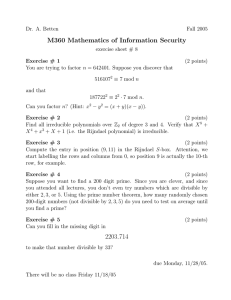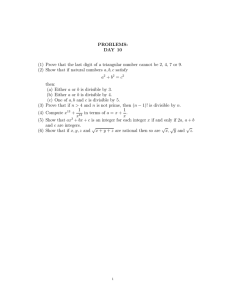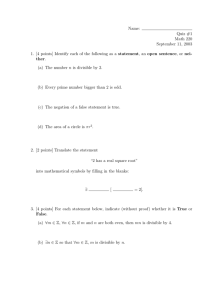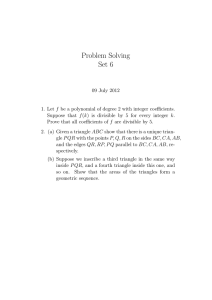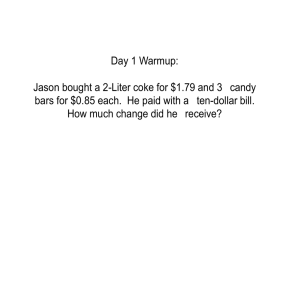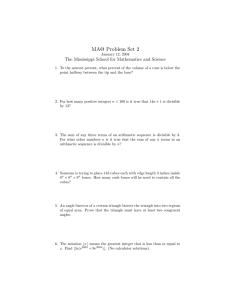18.S34 PROBLEMS #5
advertisement
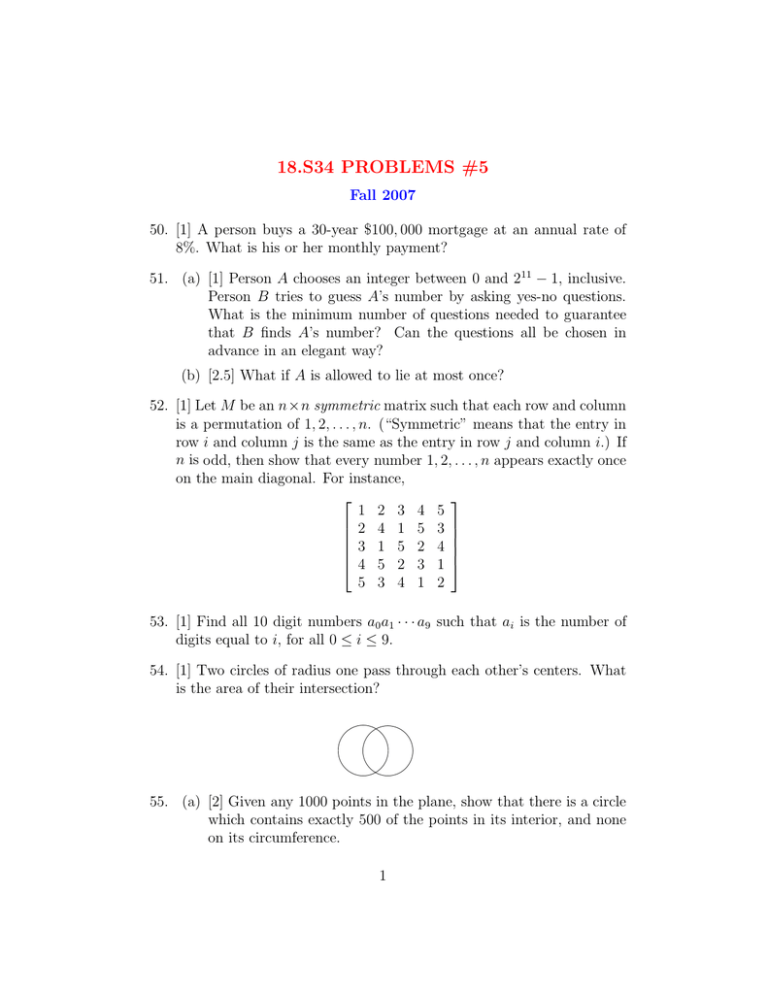
18.S34 PROBLEMS #5 Fall 2007 50. [1] A person buys a 30-year $100, 000 mortgage at an annual rate of 8%. What is his or her monthly payment? 51. (a) [1] Person A chooses an integer between 0 and 211 − 1, inclusive. Person B tries to guess A’s number by asking yes-no questions. What is the minimum number of questions needed to guarantee that B finds A’s number? Can the questions all be chosen in advance in an elegant way? (b) [2.5] What if A is allowed to lie at most once? 52. [1] Let M be an n×n symmetric matrix such that each row and column is a permutation of 1, 2, . . . , n. (“Symmetric” means that the entry in row i and column j is the same as the entry in row j and column i.) If n is odd, then show that every number 1, 2, . . . , n appears exactly once on the main diagonal. For instance, � ⎡ 1 2 3 4 5 � 2 4 1 5 3 ⎢ � ⎢ � 3 1 5 2 4 ⎢ � ⎢ � 4 5 2 3 1 ⎣ 5 3 4 1 2 53. [1] Find all 10 digit numbers a0 a1 · · · a9 such that ai is the number of digits equal to i, for all 0 � i � 9. 54. [1] Two circles of radius one pass through each other’s centers. What is the area of their intersection? �� �� �� �� 55. (a) [2] Given any 1000 points in the plane, show that there is a circle which contains exactly 500 of the points in its interior, and none on its circumference. 1 (b) [3] Given 1001 points in the plane, no three collinear and no four concyclic (i.e., no four on a circle), show that that there are exactly 250,000 circles with three of the points on the circumference, 499 points inside, and 499 points outside. 56. (a) [2.5] Let n be an integer, and suppose that n4 + n3 + n2 + n + 1 is divisible by k. Show that either k or k − 1 is divisible by 5. Hint. First show that one may assume that k is prime. Use Fermat’s theorem for the prime k, which states that if m is not divisible by k, then mk−1 − 1 is divisible by k. Try to avoid more sophisticated tools. (b) [2] Deduce that there are infinitely many primes of the form 5j +1. 57. [2] A cylindrical hole is drilled straight through and all the way through the center of a sphere. After the hole is drilled, its length is six inches. What is the volume that remains? 58. [2.5] Let T be a triangle. Erect an equilateral triangle on each side of T (facing outwards). Show that the centers of these equilateral triangles form the vertices of an equilateral triangle. 59. [5] Define a sequence X0 , X1 , . . . of rational numbers by X0 = 2 and Xn+1 = Xn − X1n for n � 0. Is the sequence bounded? 60. Let B = Z × Z, regarded as an infinite chessboard. (Here Z denotes the set of integers.) Suppose that counters are placed on some subset 2 of the points of B. A counter can jump over another counter one step vertically or horizontally to an empty point, and then remove the counter that was jumped over. Given n > 0, let f (n) denote the least number of counters that can be placed on B such that all their ycoordinates are � 0, and such that by some sequence of jumps it is possible for a counter to reach a point with y-coordinate equal to n. For instance, f (1) = 2, as shown by the following diagram. y=0 � � Similarly f (2) = 4, as shown by: y=0 � � � � (a) [2] Show that f (3) = 8 (or at least that f (3) � 8 by constructing a suitable example). (b) [2.5] Show that f (4) = 20 (or at least that f (4) � 20). (c) [3] Find an upper bound for f (5). 3 61. [3.5] Generalize Problem 12 to n dimensions as follows. Show that there exist n + 1 lattice points (i.e., points with integer coordinates) in Rn such that any two of them are the same distance apart if and only if n satisfies the following conditions: (a) If n is even, then n + 1 is a square. (b) If n � 3 (mod 4), then it is always possible. (c) If n � 1 (mod 4), then n + 1 is a sum of two squares (of non­ negative integers). The well-known condition for this is that if n + 1 = pa11 · · · par r is the factorization of n + 1 into prime powers, then ai is even whenever pi � 3 (mod 4). 4



